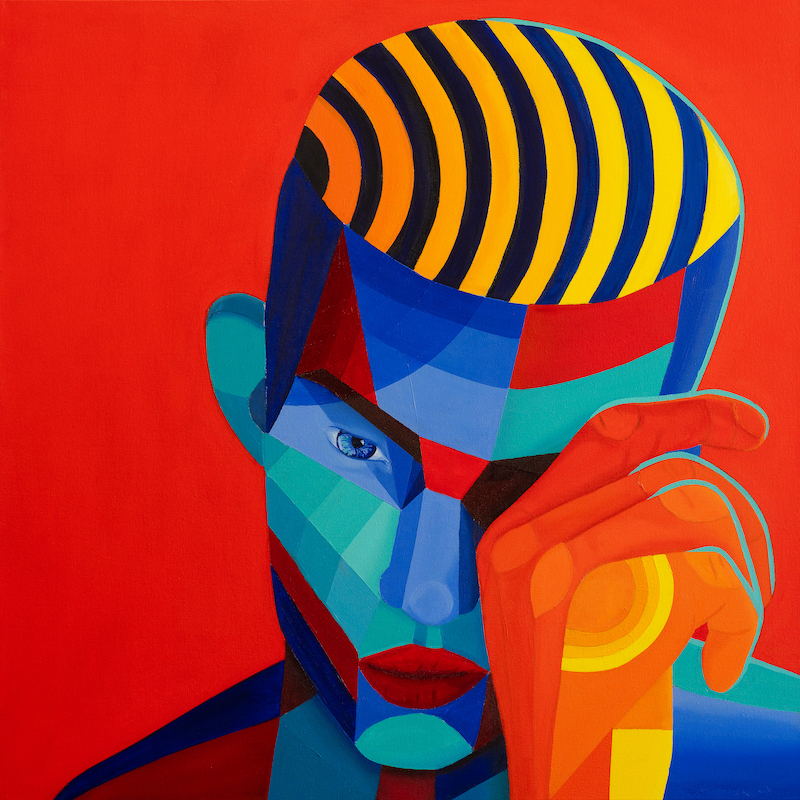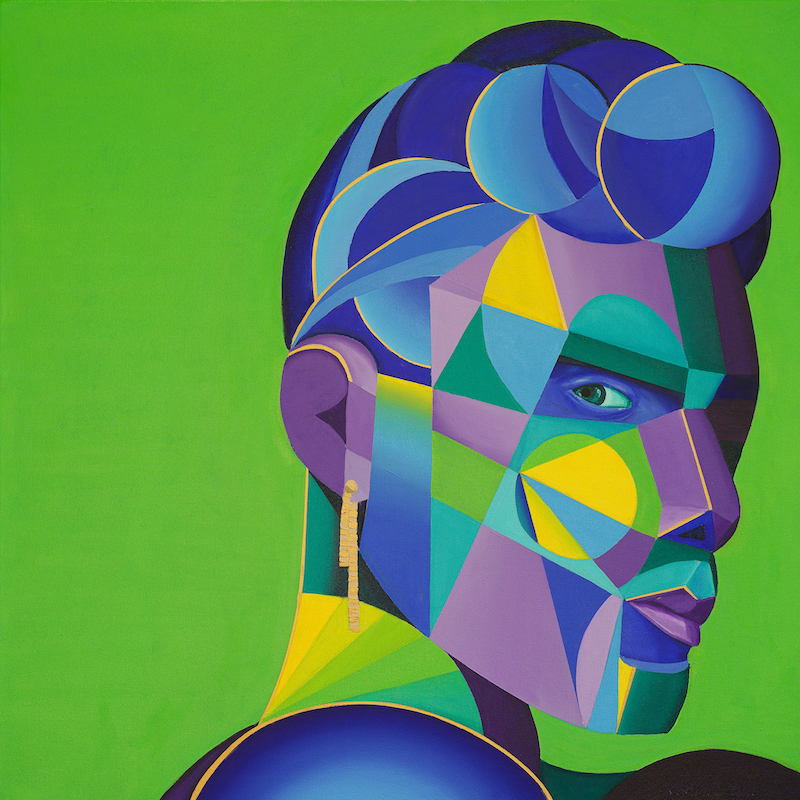
In celebration of Frieze Week New York, The Untitled Magazine is pleased to present the winner of our first-ever digital cover open call, the talented Australian figurative artist Kohlben Vodden. When it comes to Vodden, equating the act of painting to merely a “mode of expression” seems reductive. Instead, each of his works is a psychological dissection, far more concerned with mining the depths of his subjects’ subconscious identities than capturing an individual moment or mirroring their physical appearance. His colors are instantly striking; his geometric patterns are spliced into collage-like kaleidoscopes, and each piece of the puzzle is just as complex as the finished work as a whole. A human being is the sum of many parts, and Vodden breaks them down to show you each one.
It’s rare that an emerging artist arrives on the contemporary art scene with such a distinct and fully realized style. Vodden only began work on his first painting, “Orange Ebby,” in 2020, and yet its visual language feels characteristic of a veteran. Since relocating to London a few years ago from Australia, he’s continued to build upon what he started with “Orange Ebby.” In the past three years, he has already exhibited in galleries around the world, from New York to Abu Dhabi. We are thrilled to feature his painting “Green Che” on The Untitled Magazine’s May 2023 digital cover, along with an exclusive interview with the artist below. Fans of his work can additionally purchase limited edition prints of his featured paintings via The Untitled Space on Artsy.

How did you get your start as an artist?
I grew up in regional Australia, which is where culture goes to die. I desperately tried to relate, but it was evident from a very young age that I was a square peg in a round hole. One birthday, my mother gifted me a book on drawing, and I was immediately spellbound. I became obsessed with wanting to learn and practice realism art more and more. This passion was how I managed to survive in that environment until I was old enough to move away to the city. Even still, art only ever existed as a pastime passion due to a fear of failure. Fast forward to the pandemic of 2020, when I used the time and space to reevaluate my life. I rented a small studio and spent months experimenting and developing my now-recognizable style. After I published my first piece, “Orange Ebby,” online, I was given the opportunity to participate in a group exhibition with Boomer Gallery in London. That show helped me overcome my fear of failing as an artist and propelled me to where I am today, with artworks in private collections across the world.
Are you completely self-taught? If so, how did you teach yourself?
Yes, aside from the odd life drawing class here and there, I have taught myself drawing and painting by consuming as many art books as possible. Everything from the classic The Drawing Course by Charles Bargue, which was originally published in 1866, through to modern technique books like Drawing on the Right Side of the Brain by Betty Edwards, and a ton of social media content by contemporary artists like Florent Farges, who is a savant when it comes to color.
What inspired your move from Australia to London?
I enjoy – maybe even seek out – being uncomfortable. I like to operate outside my comfort zone. Relocating to London was an exciting opportunity to flip my life on its head. I love London; it’s such a melting pot of culture and so connected to Europe and the rest of the world.
Did growing up in Australia influence your visual style?
To be honest, I hadn’t thought about that before. Now that I do, yes. I think Australians are known for being fearless and colorful, and this definitely comes through in my artworks.
Your work maintains a very recognizable style. How did you develop it, and how would you describe it in your own words?
I spent months locked away and experimenting in my first little London studio during the pandemic. Prior to developing this painting style, I was focused on figurative realism in graphite. I was no longer interested in being technically competent and creating realistic copies of what I saw, I wanted to create images that hadn’t existed before I put brush to canvas.
I describe my style as abstracted geometric portraits. I don’t refer to them as truly abstract because I intentionally retain a resemblance to the subject, so the work teases the viewer’s mind with recognizable and unrecognizable attributes, creating mental excitement.
Your medium of choice is oil paint, can you tell us why that resonates with you as an artist over other mediums?
At a functional level, I love oil paint for its optical richness and versatility, but its emotional resonance comes from the challenge of using it to achieve techniques, such as the hard-edge technique, that are known to be challenging with this medium. I love using a traditional medium in unexpected ways.

“Orange Ebby” began your journey as a professional artist in 2020. What inspired you to create that piece, and what does it mean to you today?
“Orange Ebby” was not only the manifestation of months of studio work and experimentation, but it was also the first time I truly put myself out there as an artist. It represents my rawest fears and greatest pride as an artist.
How would you say you and your work have evolved since then?
I’m now including traditional painting techniques in my work. Previously, I’d avoided these for fear of being branded as old-school and painterly. Now, I’m exploring and adding my contemporary spin to techniques such as glazing.
Can you tell us about your fascination with psychology and identity? What do you find inspiring about these concepts?
I actually studied Psychology at university, where I first learned that we all have a social identity that is like a mask that we craft for the outside world. This mask is based on societal and cultural norms and expectations. We also have our personal self-image, which is not dependent on social context. I find these concepts fascinating because they are universal, yet most people are blissfully unaware of their multiple identities.
How do you explore them in your artwork?
My work explores the dissonance between our personal self-image and our social identity by creating a third identity. I do this by examining the visual image of my subject and also interviewing them to gain a deep understanding of how they project themselves to the world and what they keep for their own personal space. I then communicate these findings in colors, shapes, and patterns.
What is the message you want your paintings to communicate?
Upon seeing one of my paintings for the first time, many of my models comment along the lines of, “The painting is more like the true me than a photograph,” or, “I relate more to this image than I do to what I see in the mirror.” I think this sentiment sums up my message of being authentic to yourself. Explore and find ways to bring all of you to every situation.
Many of the figures in your paintings appear to be androgynous. Is that intentional, and is there a significance to it?
The androgynous appearance of my models in the paintings is not consciously intentional. However, through my creative process that involves deconstructing the model’s face into geometric shapes and reconstructing a new identity using these shapes, their unique life story takes precedence over their gender, which appears to have a subconscious influence on the final image.

Can you tell us about “Green Che” and the inspiration behind it?
For some, performing is something you do. For others, it is something you are. But for the true performer, it is the reason you exist. This couldn’t be truer for a creature that performs to procreate. A symbol of self-expression, sexuality, and spirituality, the peacock is nature’s ostentatious performer. It is only fitting that this glorious bird serves as inspiration for this expressive, abstracted portrait.
The subject’s affinity with nature and spirituality is conveyed through the evocative color palette dominated by green, which represents growth and renewal. Complimenting the vibrant greens are regal purples, striking blues, and opulent gold. These hues are connected to concepts such as status, achievement, and extravagance.
Can you tell us about “Red Sebastian” and the inspiration behind it?
Inspired by international fashion model Sebastian Sauvé who, in addition to working with elite fashion houses such as Givenchy and Versace, is a proponent of the contemporary art world. Concerning attributes that define his personal identity versus public image, Sebastian most identifies with the color red for its ability to evoke passion and believes his lips to be his defining facial feature. Combined with his eyes, which others most associate with his image, these physical attributes are reflected in the piece through an interplay of abstraction and realism.
Designed to command the viewers’ attention, the fearless palette is dominated by red. In color psychology, red provokes the strongest emotions of any color. It represents high-arousal concepts such as sex, power, and danger. The warm cadmium red is contrasted by the cooler complement of turquoise and its shades, which represents balance, introspection, and serenity.
You’ve had your work exhibited around the world, including in London, Berlin, New York, Abu Dhabi, and other cities. Which of your previous exhibitions means the most to you?
I’ve been so fortunate to have so many inspiring and kind gallery owners invite me to exhibit with them. Each has been really meaningful in its own way.
Are you currently working on anything that you’re excited about?
Yes, I’m currently working with some new models who are non-binary, trans, and drag performers. They are really helping me to deepen my work into the concept of identity. Stay tuned for some new, exciting paintings with these models.
Can you share any upcoming exhibitions we can look out for?
May sees me exhibiting in the annual FLUX show in London. I’m also in talks to do my first solo exhibition later this year in London. Follow me on social media or join my inner circle newsletter on my website to keep up to date on this.
You are The Untitled Magazine’s first digital cover story open call recipient! Can you tell us how you heard about the opportunity and what it means to you to have your work on the magazine cover?
It was Instagram. It seems all good things in the contemporary art world happen on Instagram! I’ve followed Untitled for years and have always admired the editorial team and the artists they feature, so it’s a genuine honor to be featured on the magazine’s cover.
To view and purchase artwork by Kohlben Vodden, visit untitled-space.art.


